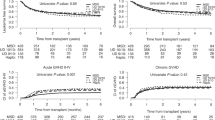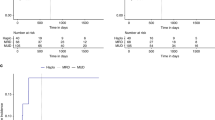Abstract
Hematopoietic cell transplantation (HCT) from a matched related donor (MRD) benefits many adults with acute myeloid leukemia (AML) in first complete remission (CR1). The majority of patients does not have such a donor and will require an alternative donor if HCT is to be undertaken. We retrospectively analyzed 226 adult AML CR1 patients undergoing myeloablative unrelated donor (URD) (10/10 match, n=62; 9/10, n=29) or MRD (n=135) HCT from 1996 to 2007. The 5-year estimates of overall survival, relapse and nonrelapse mortality (NRM) were 57.9, 29.7 and 16.0%, respectively. Failure for each of these outcomes was slightly higher for 10/10 URD than MRD HCT, although statistical significance was not reached for any end point. The adjusted hazard ratios (HRs) were 1.43 (0.89–2.30, P=0.14) for overall mortality, 1.17 (0.66–2.08, P=0.60) for relapse and 1.79 (0.86–3.74, P=0.12) for NRM, respectively, and the adjusted odds ratio for grades 2–4 acute graft-versus-host disease was 1.50 (0.70–3.24, P=0.30). Overall mortality among 9/10 and 10/10 URD recipients was similar (adjusted HR 1.16 (0.52–2.61), P=0.71). These data indicate that URD HCT can provide long-term survival for CR1 AML; outcomes for 10/10 URD HCT, and possibly 9/10 URD HCT, suggest that this modality should be considered in the absence of a suitable MRD.
This is a preview of subscription content, access via your institution
Access options
Subscribe to this journal
Receive 12 print issues and online access
$259.00 per year
only $21.58 per issue
Buy this article
- Purchase on Springer Link
- Instant access to full article PDF
Prices may be subject to local taxes which are calculated during checkout


Similar content being viewed by others
References
Fröhling S, Scholl C, Gilliland DG, Levine RL . Genetics of myeloid malignancies: pathogenetic and clinical implications. J Clin Oncol 2005; 23: 6285–6295.
Mrózek K, Heerema NA, Bloomfield CD . Cytogenetics in acute leukemia. Blood Rev 2004; 18: 115–136.
Mrózek K, Marcucci G, Paschka P, Whitman SP, Bloomfield CD . Clinical relevance of mutations and gene-expression changes in adult acute myeloid leukemia with normal cytogenetics: are we ready for a prognostically prioritized molecular classification? Blood 2007; 109: 431–448.
Koreth J, Schlenk R, Kopecky KJ, Honda S, Sierra J, Djulbegovic BJ et al. Allogeneic stem cell transplantation for acute myeloid leukemia in first complete remission: systematic review and meta-analysis of prospective clinical trials. JAMA 2009; 301: 2349–2361.
Cornelissen JJ, van Putten WL, Verdonck LF, Theobald M, Jacky E, Daenen SM et al. Results of a HOVON/SAKK donor versus no-donor analysis of myeloablative HLA-identical sibling stem cell transplantation in first remission acute myeloid leukemia in young and middle-aged adults: benefits for whom? Blood 2007; 109: 3658–3666.
Yanada M, Matsuo K, Emi N, Naoe T . Efficacy of allogeneic hematopoietic stem cell transplantation depends on cytogenetic risk for acute myeloid leukemia in first disease remission: a metaanalysis. Cancer 2005; 103: 1652–1658.
Appelbaum FR, Pearce SF . Hematopoietic cell transplantation in first complete remission versus early relapse. Best Pract Res 2006; 19: 333–339.
Appelbaum FR . Incorporating hematopoietic cell transplantation (HCT) into the management of adults aged under 60 years with acute myeloid leukemia (AML). Best Pract Res 2008; 21: 85–92.
Appelbaum FR . Allogeneic hematopoietic cell transplantation for acute myeloid leukemia when a matched related donor is not available. Hematol Educ Prog Am Soc Hematol 2008, 412–417.
Anasetti C, Perkins J, Nieder ML, Field T . Are matched unrelated donor transplants justified for AML in CR1? Best Pract Res 2006; 19: 321–328.
Zuckerman T, Rowe JM . Alternative donor transplantation in acute myeloid leukemia: which source and when? Curr Opin Hematol 2007; 14: 152–161.
Lazarus HM, Perez WS, Klein JP, Kollman C, Bate-Boyle B, Bredeson CN et al. Autotransplantation versus HLA-matched unrelated donor transplantation for acute myeloid leukaemia: a retrospective analysis from the Center for International Blood and Marrow Transplant Research. Br J Haematol 2006; 132: 755–769.
Tallman MS, Dewald GW, Gandham S, Logan BR, Keating A, Lazarus HM et al. Impact of cytogenetics on outcome of matched unrelated donor hematopoietic stem cell transplantation for acute myeloid leukemia in first or second complete remission. Blood 2007; 110: 409–417.
Krauter J, Heil G, Hoelzer D, Ottmann OG, Martin H, Lubbert M et al. Treatment of patients up to 60 years with high risk AML: final results of the AML SHG-Hannover 01/99 trial. Blood 2006; 108: 132a (abstract #433).
Appelbaum FR . Hematopoietic cell transplantation from unrelated donors for treatment of patients with acute myeloid leukemia in first complete remission. Best Pract Res 2007; 20: 67–75.
Vardiman JW, Harris NL, Brunning RD . The World Health Organization (WHO) classification of the myeloid neoplasms. Blood 2002; 100: 2292–2302.
Cheson BD, Bennett JM, Kopecky KJ, Buchner T, Willman CL, Estey EH et al. Revised recommendations of the International Working Group for Diagnosis, Standardization of Response Criteria, Treatment Outcomes, and Reporting Standards for Therapeutic Trials in Acute Myeloid Leukemia. J Clin Oncol 2003; 21: 4642–4649.
Sorror ML, Maris MB, Storb R, Baron F, Sandmaier BM, Maloney DG et al. Hematopoietic cell transplantation (HCT)-specific comorbidity index: a new tool for risk assessment before allogeneic HCT. Blood 2005; 106: 2912–2919.
Sorror ML, Giralt S, Sandmaier BM, De Lima M, Shahjahan M, Maloney DG et al. Hematopoietic cell transplantation specific comorbidity index as an outcome predictor for patients with acute myeloid leukemia in first remission: combined FHCRC and MDACC experiences. Blood 2007; 110: 4606–4613.
Petersdorf EW, Anasetti C, Martin PJ, Gooley T, Radich J, Malkki M et al. Limits of HLA mismatching in unrelated hematopoietic cell transplantation. Blood 2004; 104: 2976–2980.
Petersdorf EW, Hansen JA, Martin PJ, Woolfrey A, Malkki M, Gooley T et al. Major-histocompatibility-complex class I alleles and antigens in hematopoietic-cell transplantation. N Engl J Med 2001; 345: 1794–1800.
Przepiorka D, Weisdorf D, Martin P, Klingemann HG, Beatty P, Hows J et al. 1994 Consensus Conference on Acute GVHD Grading. Bone Marrow Transplant 1995; 15: 825–828.
Filipovich AH, Weisdorf D, Pavletic S, Socie G, Wingard JR, Lee SJ et al. National Institutes of Health consensus development project on criteria for clinical trials in chronic graft-versus-host disease: I. Diagnosis and staging working group report. Biol Blood Marrow Transplant 2005; 11: 945–956.
Paschka P, Marcucci G, Ruppert AS, Mrozek K, Chen H, Kittles RA et al. Adverse prognostic significance of KIT mutations in adult acute myeloid leukemia with inv(16) and t(8;21): a Cancer and Leukemia Group B Study. J Clin Oncol 2006; 24: 3904–3911.
Schlenk RF, Dohner K, Krauter J, Frohling S, Corbacioglu A, Bullinger L et al. Mutations and treatment outcome in cytogenetically normal acute myeloid leukemia. N EnglJ Med 2008; 358: 1909–1918.
Moore J, Nivison-Smith I, Goh K, Ma D, Bradstock K, Szer J et al. Equivalent survival for sibling and unrelated donor allogeneic stem cell transplantation for acute myelogenous leukemia. Biol Blood Marrow Transplant 2007; 13: 601–607.
Schetelig J, Bornhauser M, Schmid C, Hertenstein B, Schwerdtfeger R, Martin H et al. Matched unrelated or matched sibling donors result in comparable survival after allogeneic stem-cell transplantation in elderly patients with acute myeloid leukemia: a report from the cooperative German Transplant Study Group. J Clin Oncol 2008; 26: 5183–5191.
Yakoub-Agha I, Mesnil F, Kuentz M, Boiron JM, Ifrah N, Milpied N et al. Allogeneic marrow stem-cell transplantation from human leukocyte antigen-identical siblings versus human leukocyte antigen-allelic-matched unrelated donors (10/10) in patients with standard-risk hematologic malignancy: a prospective study from the French Society of Bone Marrow Transplantation and Cell Therapy. J Clin Oncol 2006; 24: 5695–5702.
Lee SJ, Klein J, Haagenson M, Baxter-Lowe LA, Confer DL, Eapen M et al. High-resolution donor-recipient HLA matching contributes to the success of unrelated donor marrow transplantation. Blood 2007; 110: 4576–4583.
Acknowledgements
We acknowledge the excellent care provided to the patients by the physicians and nurses of the HCT teams, as well as the work of the staff in the Long Term Follow-up office at the Fred Hutchinson Cancer Research Center. We are greatly indebted to Lacey M Hedin and Amanda M Axtman for their help with data collection. This work was supported by NIH Grants P01-CA18029, P01-AI33484, K08-CA95448, K23-CA137161, and K99-HL088021, and the Frederick Kullman Memorial Fund. JMP is supported by Career Development Awards from the Lymphoma Research Foundation and is a clinical scholar of the Damon Runyon Cancer Foundation.
Author information
Authors and Affiliations
Corresponding author
Ethics declarations
Competing interests
The authors declare no conflict of interest.
Additional information
This work was presented in part at the 2007 Annual Meetings of the American Society of Clinical Oncology (ASCO; abstract #7000) and the American Society of Hematology (ASH; abstract #330).
Rights and permissions
About this article
Cite this article
Walter, R., Pagel, J., Gooley, T. et al. Comparison of matched unrelated and matched related donor myeloablative hematopoietic cell transplantation for adults with acute myeloid leukemia in first remission. Leukemia 24, 1276–1282 (2010). https://doi.org/10.1038/leu.2010.102
Received:
Revised:
Accepted:
Published:
Issue Date:
DOI: https://doi.org/10.1038/leu.2010.102
Keywords
This article is cited by
-
Cytogenetic abnormalities predict survival after allogeneic hematopoietic stem cell transplantation for pediatric acute myeloid leukemia: a PDWP/EBMT study
Bone Marrow Transplantation (2024)
-
The improvement in overall survival from unrelated donor transplantation in Australia and New Zealand is driven by a reduction in non-relapse mortality: A study from the ABMTRR
Bone Marrow Transplantation (2022)
-
Long-term outcomes and risk factor analysis of steroid-refractory graft versus host disease after hematopoietic stem cell transplantation
Bone Marrow Transplantation (2021)
-
AlloHSCT in paediatric ALL and AML in complete remission: improvement over time impacted by accreditation?
Bone Marrow Transplantation (2019)
-
Unmanipulated haploidentical in comparison with matched unrelated donor stem cell transplantation in patients 60 years and older with acute myeloid leukemia: a comparative study on behalf of the ALWP of the EBMT
Journal of Hematology & Oncology (2018)



